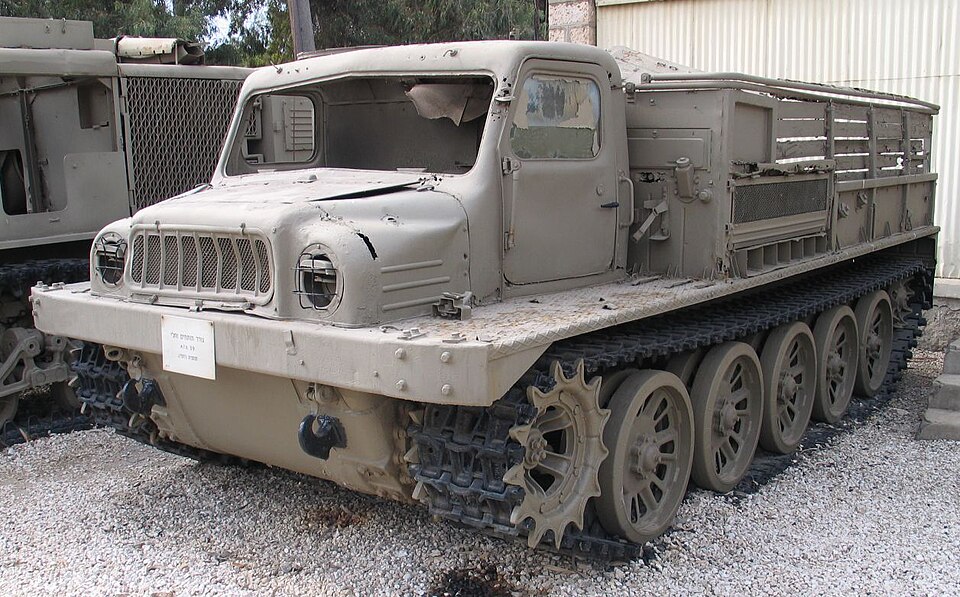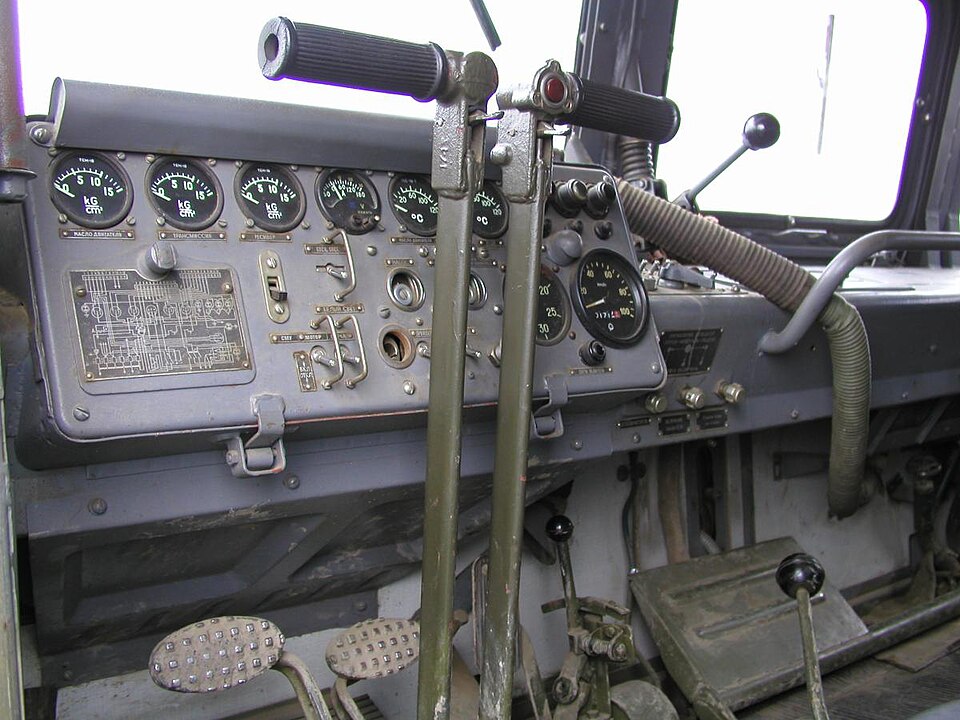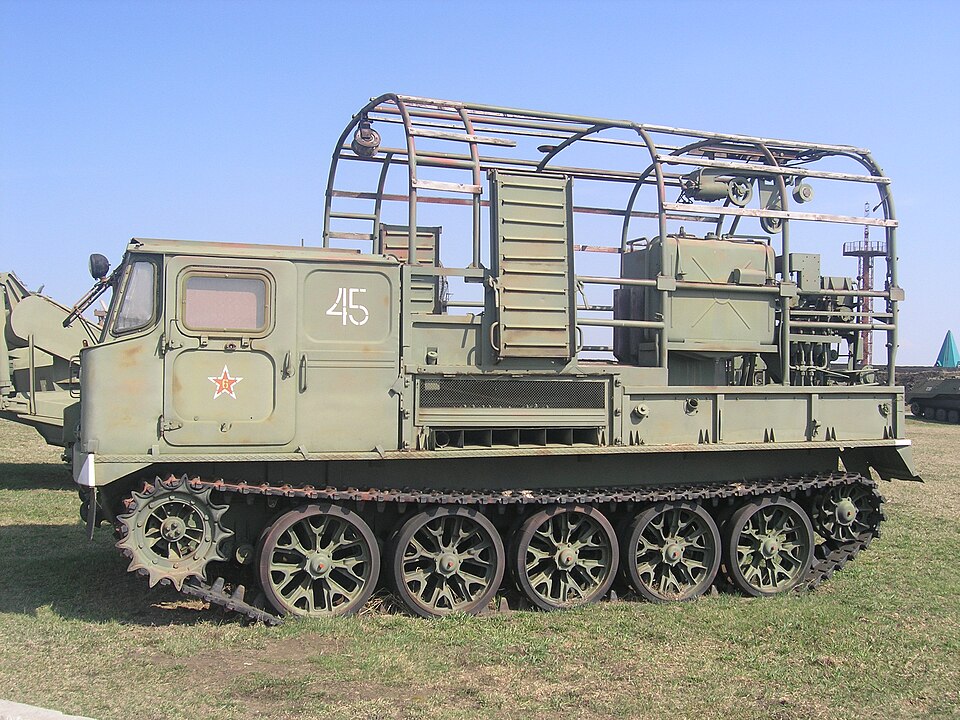ATS-59 (1959)
 Soviet Union
Soviet Union
Tracked Tractor (1959) -c15,000 built
The ATS-59 (Artilleriyskiy Tyagach Sredniy/Артиллерийский Тягач, Средний), meaning medium tracked artillery tractor, entered service in 1950 to replace the AT-S. It was defined in 1947 to be able to tow trailers or weapons up to 14 tonnes, and with a payload of 3 tonnes including ammunition and supply. Towed ordnance was the 130 mm M-46 field gun and 100 mm KS-19 air defense gun. In due time, the ATS-59 was replaced in turn by more economical and faster 6 x 6 all-terrain vehicles.
 Type 59 preserved at Batey Haosef
Type 59 preserved at Batey Haosef
During its production run, the ATS-59 was also manufactured in Poland at the Labedy Heavy Machinery Plant, which developed its own medium tracked Mazur D-350, until Soviet authorities insisted for it to be discontinued. In addition, the ATS-59 was delivered to Egypt and to Middle East countries.
The early version had a fully enclosed, two-door two-seat cab, all-steel, with a bonnet and an observation hatch on the left roof side, above the co-driver's post. Externally it was almost identical to the AT-T tractor's cab, the latter being slightly larger and with a deeper hood. The later version was called the ATS-59G, sharing the same chassis and same suspension, but with a new COE (cab over engnine) roomier enclosed control cabin close in concept to the one on the AT-S medium artillery tractor, with seven seats. The ATS-59 and 59G started to be withdrawn from service and sold at export in the 1980s, many ended in civilian companies or state-owned ones for forestry work and other roles in Siberia and remote places.
Design
The ATS-59 in its basic form had a Cargo weight of 2,7–3t, and trailer gross weight of 8–14t, unladen weight of 13,75t wen powered with the A-650 (B-2 family) diesel, for 300Kw at 1,700 rpm with power limiter for a top peed of 45 kph and fuel consumption at 40 kph making for a range of 156 km.
Development of the 59G
The ATS-59G was developed by the Special Design Bureau of the Kurgan Machine-Building Plant and adopted into service in 1970. Due to the conversion of the KMZ to the BMP-1 production, production was transferred to Poland. For this, authorities needed to force the Poles to abandon the Mazur tractor they judged superior. The ATS-59's engine unlike that of the AT-T, was at the rear of the cab, but protruding from the rear of the cargo section, limiting the size of the transportable load.
The ATS-59G was more rational approach. The latter weighted 13,750 kg with a capacity of 6(cab)+12(flatbed) a lenght overall of 6,28m 2,78 wide and 2,58 for the cabin or 2,62m on top of the tarp. Ground clearance was 42 cm and fording capacity 1.1 m without prep, and 1.5 m with covers. Max. roll angle was 25°. The Track was 2,2 m wide. Power came from a V12 diesel A-650G of the T55 main battle tank, and an overpressure NBC system was added for the cab.
General Layout
The rear flatbed had high side pillars, folding tailgate, removable roll bars, tarpaulin cover with five bows. When used for towing ordnance, the gun crew sat on benches either side of the cargo section, facing inwards.
Engine
 ATS-59G tractor
ATS-59G tractor
The tractor 12-cylinder, 4-stroke, naturally aspirated A-650G engine of the ATS-59G had compression ignition and direct fuel injection. This liquid-cooled V12 was mounted in the middle of the chassis on a dedicated subframe, securely fastened at three points. Forward on the crankshaft nose side, the engine is supported by two crankcase feet, each with two bolt holes for precise engine mounting to the subframe. These two front bolts ensure secure engine mounting and the rear engine mount needed a winch drive housing with a yoke secured to the subframe with two bolts. Shock absorbers consisting of rubber plates, reinforced with thin metal plates for elastic engine mounting.
The working process in each engine cylinder was done within two crankshaft revolutions, or four piston strokes. This process includes four strokes, intake, compression, power, and exhaust. At the end of the compression stroke, the fresh air charge is compressed to 30-35 kg/cm², making for a temperature of 600-700 °C, then fuel is injected into the cylinders at an initial pressure of 210 kg/cm² and maximum gas pressure reaches 90-100 kg/cm².
Transmission
The transmission is located at the front of the chassis, below the short bonnet, and later under the driver's post on the 59Ga. It consists of a driveline, main clutch, gearbox, final drive, steering mechanisms and final drives as well as the lubrication and cooling system. They are mounted in the transmission case.
Electrical Equipment
 ATS-59G dash
ATS-59G dash
The network rested on various power sources and auxiliary equipment, control and gages, wiring. There were three batteries and a DC generator driven by the engine crankshaft. The voltage regulator maintains the generator's voltage at a constant level. When the engine was not running or at low engine speeds, the loads were powered by the batteries, including starter, pumps, heaters, fans, lighting, alarms, control gauges operating on 24 V DC. Auxiliary equipment: Voltage regulator, switches, control instruments (voltmeter, ammeter, tachometer, pressure gauges, speedometer). The wiring system is single-and two-wire. The battery switch could be turned off. At night, a portable lamp was usabled by using a two-wire socket. BPVLE wires of varying cross-sections are used throughout.
Fuel and Range
Fuel tank capacity was 580 liters, with one 100 main fuel tank and two 240L tanks, and then 240 liters optional by adding four additional tanks. Fuel consumption was 65.8 l/100 km. The vehicle shared its drivetrain party with the T-54/55, but its cast roadwheels were specific, as the drive sprockets. Turning radius was 11.5–12 meters in first position of the levers and 3.4–3.5m in second position. The range was limited to 350 km with cargo and trailer and 500 km with additional fuel tanks. It used the MT-16P diesel oil.
Other Equipments
The winch serially installed is for self-unditching. It had pulling and lowering loads and a trailer mode or for crossing bridges. There was a 100-meter-long cable with max tension of 15 tf when pulling, and 6 tf when towing. It is mounted on a special frame under the platform floor secured by two longitudinal beams and two transverse plates, bolted to the tractor body. It had its own gearbox, laying drum, cable guide, traction rollers, clutch, cable outlet unit, control drive, driven by the main engine crankshaft through a special drive connected to the clutch.
The towing Hitch for ordnance and trailers installed at the rear uses two-way shock absorber cushions, housed in a recess in the rear plate of the body. Pneumatic Equipment was for the brake drive of the tractor and trailer, connected to the main clutch servo drive, and various auxiliary systems, comprising a compressor and oil/water separator, a brake valve, a receiver, a main clutch servo drive pneumatic chamber, a parking brake, two isolating valves and a coupling head. The ATS-59 also went equipped woth windshield washer and wipers, heater, air blower, plus the MZA-3 refueling system with diesel and oil from drums and containers, as well as fire-fighting equipment (two halon type extinguisher bottle between the cab and chassis).
Variants
 P-286 cable layer
P-286 cable layer
ATS-59
Basic version with the early 2-seat cab and bonnet.
ATS-59G (Object 668)
Improved variant with a redesigned cab, NBC protection. To sub-variants:
One with no traction winch, minor modifications to the body and cargo platform, light weight.
One with a mounting boom, manual planetary winch, modified cabin higher weight, minor modifications, body and cargo.
ATS-59S (Object 667)
1,65 m fifth wheel from the ZiL-157V, for towing PR-11B and 5T52 semitrailer, 6.75 tons.
GET-S (TG-4)
Medium-sized tracked recovery tractor with another type of bulldozer blade
STK-59GMS
Utility variant with a cab for welding and processing, ATS-59G chassis.
P-286
Cable layer variant.
S-75 tractor
Modified tractor for the S-75 Dvina missile PR-11 semi-trailer transporter-launcher.
OST-59G
Combat engineering variant, with a hydraulically-operated dozer blade fwd.
GTs-5-40
Civilian 5,000-liter fire truck with the PN-40UV fire pump, manufactured at Pozhmashina OJSC (Torzhok).
TM-96
Civilian 3,000-kg skidder manufactured from the ATS-59G at the Kharkiv Automobile Repair Plant.
RL-21
Egyptian MLRS, 122-mm rocket launcher based on the ATS-59G.
Operators

Passed on to Russia

Moldova

Ukraine

Bulgaria

Egypt

Finland
|
| Dimensions: | 6.28 x 2.3 x 2.5 m (20.6 ft x 7 ft 7 in/8 ft 2 in) |
| Total weight: | 13t (29,000 lb), up to 16t (35,000 lb) |
| Crew: | 2 (ATS-59G 7), +14 in flatbed |
| Propulsion: | A-650 V-12 water-cooled diesel, 300 hp (220 kW) at 1700 rpm |
| Propulsion 59G: | A-650G, V12 4-stroke diesel rated for 300 hp at 1.700 rpm |
| Speed: | 39 km/h (24 mph) |
| Range, flat: | 350 km (220 mi), 500 km (310 mi) with long range fuel tanks |
| Payload: | 3t (6,600 lb)+ 14t (31,000 lb) towed |
| Production: | |
Operations
The ATS-59 remained in production as the ATS-59G until 1988, before being replaced by the improved AT-S. It was used as artillery tractor organically for decades, until phases out gradually after the fall or USSR. Like seen above, many were exported and the remainder purchased back by state own companies in Siberia and other remote places for heavy duty work. It saw action with Egyptian forces in the 1973 war, as well as with north Vietnamese forces from the 1960s onwards, both the basic ATS-59 and ATS-59G. Poland also retained them until 1990.
It was still in use however, coming from depots, some modified as tracked armed plarforms such as one preculiar vehicles spotted in April 2023, with a rear-mounted 25mm 2M-3M naval gun. In July 2024, several were spotted being transported to the front on a military train, perhaps for other conversions. Many are still active in their export countries. According to Oryx, the Russian army lost 5 ATS-59G artillery tractor as documented in ONSINT.